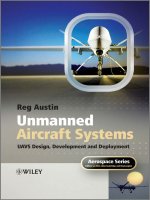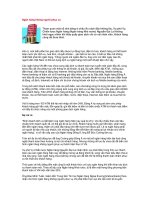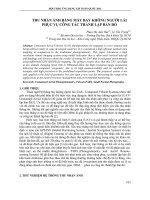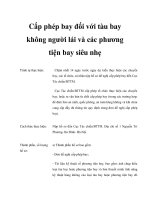Tài liệu máy bay không người lái Unmmand Aircraft System By
Bạn đang xem bản rút gọn của tài liệu. Xem và tải ngay bản đầy đủ của tài liệu tại đây (5.07 MB, 365 trang )
P1: OTE/OTE/SPH P2: OTE
FM JWBK459-Austin March 19, 2010 12:44 Printer Name: Yet to Come
UNMANNED AIRCRAFT
SYSTEMS
UAVS DESIGN, DEVELOPMENT
AND DEPLOYMENT
Reg Austin
Aeronautical Consultant
A John Wiley and Sons, Ltd., Publication
P1: OTE/OTE/SPH P2: OTE
FM JWBK459-Austin March 19, 2010 12:44 Printer Name: Yet to Come
P1: OTE/OTE/SPH P2: OTE
FM JWBK459-Austin March 19, 2010 12:44 Printer Name: Yet to Come
UNMANNED AIRCRAFT
SYSTEMS
P1: OTE/OTE/SPH P2: OTE
FM JWBK459-Austin March 19, 2010 12:44 Printer Name: Yet to Come
Aerospace Series List
Path Planning Strategies for Cooperative
Autonomous Air Vehicles
Tsourdos et al August 2010
Introduction to Antenna Placement & Installation Macnamara April 2010
Principles of Flight Simulation Allerton October 2009
Aircraft Fuel Systems Langton et al May 2009
The Global Airline Industry Belobaba April 2009
Computational Modelling and Simulation of
Aircraft and the Environment: Volume 1 - Platform
Kinematics and Synthetic Environment
Diston April 2009
Handbook of Space Technology Ley, Wittmann, Hallmann April 2009
Aircraft Performance Theory and Practice for Pilots Swatton August 2008
Surrogate Modelling in Engineering Design:
A Practical Guide
Forrester, Sobester, Keane August 2008
Aircraft Systems, 3
rd
Edition Moir & Seabridge March 2008
Introduction to Aircraft Aeroelasticity And Loads Wright & Cooper December 2007
Stability and Control of Aircraft Systems Langton September 2006
Military Avionics Systems Moir & Seabridge February 2006
Design and Development of Aircraft Systems Moir & Seabridge June 2004
Aircraft Loading and Structural Layout Howe May 2004
Aircraft Display Systems Jukes December 2003
Civil Avionics Systems Moir & Seabridge Dec 2002
P1: OTE/OTE/SPH P2: OTE
FM JWBK459-Austin March 19, 2010 12:44 Printer Name: Yet to Come
UNMANNED AIRCRAFT
SYSTEMS
UAVS DESIGN, DEVELOPMENT
AND DEPLOYMENT
Reg Austin
Aeronautical Consultant
A John Wiley and Sons, Ltd., Publication
P1: OTE/OTE/SPH P2: OTE
FM JWBK459-Austin March 19, 2010 12:44 Printer Name: Yet to Come
This edition first published 2010
C
2010 John Wiley & Sons Ltd
Registered office
John Wiley & Sons Ltd, The Atrium, Southern Gate, Chichester, West Sussex, PO19 8SQ, United Kingdom
For details of our global editorial offices, for customer services and for information about how to apply for permission to
reuse the
copyright material in this book please see our website at www.wiley.com.
The right of the author to be identified as the author of this work has been asserted in accordance with the Copyright,
Designs and Patents Act 1988.
All rights reserved. No part of this publication may be reproduced, stored in a retrieval system, or transmitted, in any form
or by any means, electronic, mechanical, photocopying, recording or otherwise, except as permitted by the UK Copyright,
Designs and Patents Act 1988, without the prior permission of the publisher.
Wiley also publishes its books in a variety of electronic formats. Some content that appears in print may not be available in
electronic books.
Designations used by companies to distinguish their products are often claimed as trademarks. All brand names and
product names used in this book are trade names, service marks, trademarks or registered trademarks of their respective
owners. The publisher is not associated with any product or vendor mentioned in this book. This publication is designed to
provide accurate and authoritative information in regard to the subject matter covered. It is sold on the understanding that
the publisher is not engaged in rendering professional services. If professional advice or other expert assistance is required,
the services of a competent professional should be sought.
Library of Congress Cataloging-in-Publication Data
Austin, Reg.
Unmanned aircraft systems : UAVS design, development and deployment / Reg Austin.
p. cm.
Includes index.
ISBN 978-0-470-05819-0 (cloth)
1. Drone aircraft. 2. Airplanes–Radio control. 3. Navigation (Aeronautics) I. Title.
TL718.A97 2010
623.74
69–dc22 2009054381
A catalogue record for this book is available from the British Library.
ISBN 9780470058190 (H/B)
Set in 9/11pt Times by Aptara Inc., New Delhi, India
Printed and bound in Great Britain by CPI Antony Rowe, Chippenham, Wiltshire, UK
P1: OTE/OTE/SPH P2: OTE
FM JWBK459-Austin March 19, 2010 12:44 Printer Name: Yet to Come
Mrs Ann Austin, BSc.
1938–2010
Throughout our 50 years of happy marriage, Ann was most supportive of me in my work.
From our helicopter wedding in 1960 through to her organising and conducting the day tours for the
wives of the delegates of the International UAS Conferences, Ann became known and well-liked in
several aeronautical circles world-wide.
She did this in addition to bearing and raising our two sons and having her own career in education.
One of her dreams was to see the publication of this book which could not have been written without her
encouragement and support.
The realisation of that dream was stolen from her by her death from cancer.
Shewillbesorelymissedbysomany.
I dedicate the book to her memory.
P1: OTE/OTE/SPH P2: OTE
FM JWBK459-Austin March 19, 2010 12:44 Printer Name: Yet to Come
P1: OTE/OTE/SPH P2: OTE
FM JWBK459-Austin March 19, 2010 12:44 Printer Name: Yet to Come
Contents
Foreword xiii
Acknowledgements xiv
Series Preface xv
Preface xvii
Units and Abbreviations xix
1 Introduction to Unmanned Aircraft Systems (UAS) 1
1.1 Some Applications of UAS 1
1.2 What are UAS? 3
1.3 Why Unmanned Aircraft? 5
1.4 The Systemic Basis of UAS 9
1.5 System Composition 9
References 15
Part 1 THE DESIGN OF UAV SYSTEMS 17
2 Introduction to Design and Selection of the System 19
2.1 Conceptual Phase 19
2.2 Preliminary Design 20
2.3 Detail Design 20
2.4 Selection of the System 20
3 Aerodynamics and Airframe Configurations 25
3.1 Lift-induced Drag 25
3.2 Parasitic Drag 26
3.3 Rotary-wing Aerodynamics 29
3.4 Response to Air Turbulence 32
3.5 Airframe Configurations 34
3.6 Summary 42
References 43
4 Characteristics of Aircraft Types 45
4.1 Long-endurance, Long-range R
ˆ
ole Aircraft 45
4.2 Medium-range, Tactical Aircraft 55
P1: OTE/OTE/SPH P2: OTE
FM JWBK459-Austin March 19, 2010 12:44 Printer Name: Yet to Come
viii Contents
4.3 Close-range/Battlefield Aircraft 59
4.4 MUAV Types 66
4.5 MAV and NAV Types 68
4.6 UCAV 70
4.7 Novel Hybrid Aircraft Configurations 71
4.8 Research UAV 74
References 74
5 Design Standards and Regulatory Aspects 75
5.1 Introduction 75
5.2 United Kingdom 76
5.3 Europe 88
5.4 United States of America 88
5.5 Conclusion 89
References 89
6 Aspects of Airframe Design 91
6.1 Scale Effects 91
6.2 Packaging Density 93
6.3 Aerodynamics 94
6.4 Structures and Mechanisms 95
6.5 Selection of power-plants 101
6.6 Modular Construction 106
6.7 Ancillary Equipment 112
References 112
7 Design for Stealth 113
7.1 Acoustic Signature 114
7.2 Visual Signature 115
7.3 Thermal Signature 116
7.4 Radio/Radar Signature 117
7.5 Examples in Practice 118
Reference 126
8 Payload Types 127
8.1 Nondispensable Payloads 128
8.2 Dispensable Payloads 141
Reference 141
9 Communications 143
9.1 Communication Media 143
9.2 Radio Communication 144
9.3 Mid-air Collision (MAC) Avoidance 151
9.4 Communications Data Rate and Bandwidth Usage 151
9.5 Antenna Types 152
References 154
10 Control and Stability 155
10.1 HTOL Aircraft 155
10.2 Helicopters 159
P1: OTE/OTE/SPH P2: OTE
FM JWBK459-Austin March 19, 2010 12:44 Printer Name: Yet to Come
Contents ix
10.3 Convertible Rotor Aircraft 163
10.4 Payload Control 165
10.5 Sensors 165
10.6 Autonomy 167
References 167
11 Navigation 169
11.1 NAVSTAR Global Positioning System (GPS) 169
11.2 TACAN 170
11.3 LORAN C 170
11.4 Inertial Navigation 171
11.5 Radio Tracking 171
11.6 Way-point Navigation 172
References 172
12 Launch and Recovery 173
12.1 Launch 173
12.2 Recovery 177
12.3 Summary 181
13 Control Stations 183
13.1 Control Station Composition 183
13.2 Open System Architecture 185
13.3 Mini-UAV ‘Laptop’ Ground Control Station 185
13.4 Close-range UAV Systems GCS 186
13.5 Medium- and Long-range UAV System GCS 190
13.6 Sea Control Stations (SCS) 195
13.7 Air Control Stations (ACS) 195
14 Support Equipment 197
14.1 Operating and Maintenance Manuals 197
14.2 Consumables 198
14.3 Replaceable Components 198
14.4 Vulnerable and On-condition Components 198
14.5 Tools 198
14.6 Subsidiary Equipment 199
15 Transportation 201
15.1 Micro-UAV 201
15.2 VTOL Close-range Systems 201
15.3 HTOL Close-range Systems 201
15.4 Medium-range Systems 202
15.5 MALE and HALE Systems 203
16 Design for Reliability 205
16.1 Determination of the Required Level of Reliability 206
16.2 Achieving Reliability 208
16.3 Reliability Data Presentation 210
16.4 Multiplexed Systems 212
16.5 Reliability by Design 213
16.6 Design for Ease of Maintenance 216
P1: OTE/OTE/SPH P2: OTE
FM JWBK459-Austin March 19, 2010 12:44 Printer Name: Yet to Come
x Contents
17 Design for Manufacture and Development 217
Part 2 THE DEVELOPMENT OF UAV SYSTEMS 221
18 Introduction to System Development and Certification 223
18.1 System Development 223
18.2 Certification 224
18.3 Establishing Reliability 224
19 System Ground Testing 227
19.1 UAV Component Testing 227
19.2 UAV Sub-assembly and Sub-system Testing 228
19.3 Testing Complete UAV 230
19.4 Control Station Testing 236
19.5 Catapult Launch System Tests 237
19.6 Documentation 237
20 System In-flight Testing 239
20.1 Test Sites 239
20.2 Preparation for In-flight Testing 240
20.3 In-flight Testing 242
20.4 System Certification 243
Part 3 THE DEPLOYMENT OF UAV SYSTEMS 245
21 Operational Trials and Full Certification 247
21.1 Company Trials 247
21.2 Customer Trials and Sales Demonstrations 248
22 UAV System Deployment 249
22.1 Introduction 249
22.2 Network-centric Operations (NCO) 251
22.3 Teaming with Manned and Other Unmanned Systems 252
23 Naval R
ˆ
oles 253
23.1 Fleet Detection and Shadowing 254
23.2 Radar Confusion 254
23.3 Missile Decoy 255
23.4 Anti-submarine Warfare 255
23.5 Radio Relay 256
23.6 Port Protection 256
23.7 Over-beach Reconnaissance 257
23.8 Fisheries Protection 257
23.9 Detection of Illegal Imports 257
23.10 Electronic Intelligence 257
23.11 Maritime Surveillance 258
23.12 Summary 258
P1: OTE/OTE/SPH P2: OTE
FM JWBK459-Austin March 19, 2010 12:44 Printer Name: Yet to Come
Contents xi
24 Army R
ˆ
oles 259
24.1 Covert Reconnaissance and Surveillance 259
24.2 Fall-of-shot Plotting 261
24.3 Target Designation by Laser 261
24.4 NBC Contamination Monitoring 263
24.5 IED and Landmine Detection and Destruction 266
24.6 Electronic Intelligence 266
24.7 Teaming of Manned and Unmanned Systems 266
24.8 System Mobility 266
24.9 Persistent Urban Surveillance 267
25 Air Force R
ˆ
oles 269
25.1 Long-range Reconnaissance and Strike 269
25.2 Airborne Early Warning 269
25.3 Electronic Intelligence 269
25.4 Pre-strike Radar and Anti-aircraft Systems Counter 270
25.5 Interception 270
25.6 Airfield Security 270
26 Civilian, Paramilitary and Commercial R
ˆ
oles 273
26.1 Aerial Photography* 273
26.2 Agriculture 273
26.3 Coastguard and Lifeboat Institutions 274
26.4 Customs and Excise 275
26.5 Conservation 275
26.6 Electricity Companies 275
26.7 Fire Services 276
26.8 Fisheries 276
26.9 Gas and Oil Supply Companies 277
26.10 Information Services 277
26.11 Local Civic Authorities 277
26.12 Meteorological Services* 277
26.13 Traffic Agencies 277
26.14 Ordnance Survey 278
26.15 Police Authorities* 278
26.16 Rivers Authorities and Water Boards 278
26.17 Survey Organisations 278
26.18 Communications Relay 278
26.19 Landmine Detection and Destruction 279
26.20 Other Applications 279
References 279
Part 4 UAS FUTURE 281
27 Future Prospects and Challenges 283
27.1 Introduction 283
27.2 Operation in Civilian Airspace 284
27.3 Power-plant Development 288
27.4 Developments in Airframe Configurations 292
P1: OTE/OTE/SPH P2: OTE
FM JWBK459-Austin March 19, 2010 12:44 Printer Name: Yet to Come
xii Contents
27.5 Autonomy and Artificial Intelligence 299
27.6 Improvement in Communication Systems 301
References 301
28 UAV Systems Continuing Evolution 303
28.1 Introduction 303
28.2 Cruise Missiles 304
28.3 World War II Systems 305
28.4 The 1950s 306
28.5 The 1960s 306
28.6 The 1970s 308
28.7 The 1980s 309
28.8 The 1990s 311
28.9 The 2000s 312
28.10 The 2010s 315
28.11 Into the Future 316
Appendix A: UAS Organisations 319
A.1 Conferences 319
A.2 Industry Associations 319
A.3 Press Organisations 320
A.4 Useful Websites 320
A.5 Test Site Facilities 320
A.6 Regulators 321
Index 323
P1: OTE/OTE/SPH P2: OTE
FM JWBK459-Austin March 19, 2010 12:44 Printer Name: Yet to Come
Foreword
The author, Reg Austin, started his career in aeronautics in 1945 at the Bristol Aeroplane Company Ltd,
where he served a student apprenticeship and became involved in the design of the Bristol airliners, high-
speed fighter projects and helicopters, becoming eventually a senior aerodynamicist in the Helicopter
Department. He also learnt to fly gliders and light aircraft.
He moved to become Chief Engineer in the Helicopter Department, Auster Aircraft Limited for three
years, but then returned to Bristol to hold various senior positions in Bristol Helicopters.
When Westland Helicopters took over Bristol Helicopters in 1960, Reg was appointed Chief Project
Engineer responsible for new Westland designs. Amongst other projects such as compound helicopters
and tilt-wing aircraft, he conceived and led the design of the Lynx helicopter and introduced the discipline
of Operational Research to the Company.
In 1967 he conceived the idea of the plan-symmetric unmanned helicopter and led the team developing
and flight-testing the experimental Mote and Wisp surveillance UAVs. He initiated the work on the
Westland Wideye UAV.
In 1980 Reg joined ML Aviation as Flight Systems Manager, covering various experimental projects
such as the Kestrel rotary-wing munitions delivery system, the Sea-star naval fixed-wing target and
particularly the development and world-wide field trials of the Sprite rotary wing VTOL UAV system.
He was Chairman of the NATO VTOL UAV Engineering Group for some years.
Moving to academia in 1991, Reg has remained busy in the aeronautical field as a Consultant and
lecturer, covering all aspects of aircraft design and operation including unmanned air vehicle systems.
He is a Professor, Eur Ing, MSc, Fellow of the Royal Aeronautical Society and a member of its Rotorcraft
Committee, and Vice Chairman of the Bristol International Unmanned Air Vehicle Systems Conferences
which he initiated in 1978.
With such a wide ranging knowledge of all aspects of UAVs he is ideally equipped to write this book.
It draws on his extensive first-hand experience of system design, giving examples from his own activities.
Rarely do we have the opportunity to learn from engineers who have been pioneers in the application of a
new field of technology whilst it is still evolving. This book therefore should be compulsory reading for
everyone working (or planning to work) in the field of UAV systems. In particular what might be called
non-technical aspects should not be overlooked and Chapter 5 should be very useful in this respect.
David J Walters BSc, CEng, AFRAeS, AinstP
Retired Director of Future Systems, MOD
P1: OTE/OTE/SPH P2: OTE
FM JWBK459-Austin March 19, 2010 12:44 Printer Name: Yet to Come
Acknowledgements
The author wishes to acknowledge the help and advice given to him in the preparation of this book.
The following organisations are thanked for permission to use photographs and data of their products
for illustration purposes. AeroVironment Inc., All American Industries, Inc., BAE Systems, Beijing
University of Aeronautics and Aerospace, Bell Helicopter Textron Inc., Bernard Hooper Engines, Boe-
ing/Insitu, Cloud Cap Technologies, Controp, Cranfield University, Denel Aerospace, EADS Defence
and Security, General Atomics Aeronautical Systems Inc., GFS Projects UK, Honeywell, IAI Malat,
Lockheed Martin, Northrop-Grumman, Prox Dynamics, Qinetiq plc., Rafael, RUAG Aerospace, Sandia
National Laboratories, Schiebel Elektronische Geraete Gmbh, Selex, Wescam, Yamaha Motor Company.
My thanks are also due to: Colin Coxhead, for data on piston engines; Marilyn Gilmore of dstl, for
advice on stealth; Kenneth Munson and Jane’s Unmanned Aerial Vehicles and Targets, for data and
advice; John Russell, on pilot vision; Arthur Richards of Bristol University, on artificial intelligence;
Shephard Press, for information and contacts. I am grateful to The Bristol International UAV Systems
Conferences and Jane’s Unmanned Aerial Vehicles and Targets for help with the list of abbreviations
and acronyms.
My special thanks are offered to Rob Frampton for his advice on autonomy and navigation systems,
together with his support in reviewing the draft of this book.
Finally, my Very Special Thanks go to my dear wife, Ann, for her forbearance in accepting the
disruption of our social life and for her encouragement, feeding and watering me, during the preparation
of this book.
P1: OTE/OTE/SPH P2: OTE
FM JWBK459-Austin March 19, 2010 12:44 Printer Name: Yet to Come
Series Preface
Unmanned air vehicles were once the stuff of rumour and legend, identified in the press as new and
mysterious. “New shapes in the sky,” declared the headlines at one time in the recent past. Now they seem
to be commonplace, on the battlefield at least, where they are seen carrying out surveillance missions
and deploying weapons with great accuracy. They are now truly the solution to some of the dull, dirty
and dangerous tasks for which they were first proposed.
Apart from military applications there are many jobs to be performed in commercial and government
applications in surveillance, monitoring and trouble-shooting in the fields of utilities, maritime rescue,
customs and excise and agriculture to name only a few. Some police forces are collaborating with industry
to develop systems to replace helicopter surveillance. The main drawback to their application has been
the difficulty in obtaining certification to operate in controlled airspace.
There are many classes of unmanned vehicle in existence, and many types within each class, developed
by many manufacturers. The classes range from insect like vehicles, through hand launched sub-scale
models to full size long endurance types. They are all capable of carrying some form of sensor and of
relaying sensor information to the ground. Most are remotely piloted, and some experimental types are
being operated on controlled ranges as part of a gradual progression towards full autonomy, where they
will be capable of performing missions with minimum human intervention.
This book introduces the classes and types of platforms available, and examines their performance, the
design requirements for aerodynamics, structure, propulsion and systems to suit particular roles. Sensor
and avionic payloads are discussed as well as the data links and communications suites required to
complete the payload. Methods of launch and recovery are presented as an important part of deployment.
This is a good introduction to the subject and it takes the Aerospace Series into the world of remotely
piloted unmanned air vehicles, and more importantly to the realm of autonomous systems where great
challenges remain to be overcome.
Allan Seabridge
P1: OTE/OTE/SPH P2: OTE
FM JWBK459-Austin March 19, 2010 12:44 Printer Name: Yet to Come
P1: OTE/OTE/SPH P2: OTE
FM JWBK459-Austin March 19, 2010 12:44 Printer Name: Yet to Come
Preface
The development and entry into service of unmanned air vehicle systems has a long, drawn-out history.
Unfortunately, the vision of engineers and scientists is seldom matched by that of administrators,
regulators or financiers. The availability of UAV systems has also often depended upon maturation of
the requisite technology.
UAV systems are now being operated by several military forces and currently, to a more limited extent,
by civilian organisations. These latter operations, however, may eventually expand to exceed, in number
and diversity, those of the military.
The systematic nature of UAV systems, which is achieved through the combination of many elements
and their supporting disciplines, will be emphasised throughout this book. Although the aircraft element
is but one part of the coordinated system, it is almost certainly the element which drives the requirements
of the other system elements to the greatest extent.
The aircraft itself will have much in common with manned aircraft, but also several differences which
are explained. These differences often result from the differences in operational requirements compared
with manned aircraft, for example the need to take off from remote, short, unprepared airstrips or to fly
for long periods at very high altitudes. The performance of the aircraft is often enhanced by not having
to carry the weight of equipment and structure required to accommodate aircrew, and having a lower
aerodynamic drag for the same reason. The UAV also often benefits from advantageous scale effects
associated with a smaller aircraft.
It is not the author’s intention to provide a textbook to expound in detail the many UAV engineering
disciplines, which include, of course, aerodynamics, electronics, economics, materials, structures, ther-
modynamics, etc., but rather to show how the disciplines are integrated into the design, development and
deployment of the UAV systems. It is the intention also to explain the manner in which their application
may differ from their use in other aerospace and engineered systems.
On occasions, for example in Chapter 3, the author has entered into the theory of the discipline in
order to dispel some myths and to bring the reader’s attention to the significant aspects without the need
for the reader to find his way through a specialist textbook on the subject.
Similarly, the history and evolution of UAV Systems (Chapter 28) is considered only in order to point
out how UAS have evolved and where lessons have been, or should have been, learned from that history
and the probable way forward.
The systems nature of UAV makes it impractical and undesirable to cover elements in isolation, some
aspects therefore appear in more than one chapter, but at different levels of detail. The author intends this
to be reinforcement of key aspects. For a more detailed knowledge of the several disciplines, the reader
is directed to the specialist works listed in the reference sections.
Examples of several systems and their sub-systems are used to explain the principles involved. The
technology continues rapidly to evolve, so that the examples used will not necessarily reflect the latest
available when this book reaches publication, but the principles will still apply. The reader is again
referred to the reference sections for up-to-date listings of current systems.
P1: OTE/OTE/SPH P2: OTE
FM JWBK459-Austin March 19, 2010 12:44 Printer Name: Yet to Come
xviii Preface
In making a comparison between the attributes of the several UAS, where available, the author has
used the data supplied by the manufacturers to whom he is grateful for their help. In other cases, where
the data has not been made available, the author has derived results from scaling photographs and making
calculations of performance using established methods. This is done in order to explain several of the
differences between manned aircraft systems and UAV and also between the different configurations
of UAV often decided by the specific type of operation that they carry out. The author regrets any
misconceptions, should they arise, from this practice but feels that it was necessary to complete the work
rather than let it be limited through the lack of authorised data.
The author has been involved with aircraft of all types, both manned and unmanned, during his long
career in aviation. It is, however, his time spent working with unmanned rotorcraft and seeing their
great versatility, that has contributed most to his understanding of the issues entailed in developing and
operating UAV systems.
His ‘hands-on’ experience with UAV began in 1968 at Westland Helicopters with responsibility for
the Mote, Wisp, Pupil and initial Wideye design and development VTOL programmes, and subsequently
at M L Aviation, with both fixed- and rotary-wing programmes. The most advanced of all of these
programmes was that of the Sprite UAV system at M L Aviation. A number of these systems were
deployed around the world, operating by day and night, in all weathers, off-land and off-board ship on
many tasks and with a wide range of payloads.
The author was also privileged to have been invited to observe the trials of UAV systems by other
manufacturers and to have the opportunity to discuss the activities of many other developers and operators
of UAV systems world-wide, especially through contacts made in his involvement over 30 years with
the Bristol International UAV Systems Conferences.
However, his leadership of the versatile Sprite programme gave the greatest insight into all aspects
of the design, development and deployment of UAV systems, and he makes no apologies for leaning on
this experience for many of the examples in the book.
It is the author’s hope that this book will be of use not only to future students, designers, developers
and operators of UAV systems, but also to procurement and regulatory organisations.
Reg Austin
P1: OTE/OTE/SPH P2: OTE
FM JWBK459-Austin March 19, 2010 12:44 Printer Name: Yet to Come
Units and Abbreviations
Units
All units of measurement throughout this book conform to the Syst
`
eme Internationale, with alternative
units shown in brackets where appropriate.
Abbreviations: Acronyms
The following terms are not necessarily all to be found in this book, but are terms which are likely to be
encountered in general literature or conferences on UAV systems.
AA Anti-aircraft
AAA Anti-aircraft artillery
AAIB Air Accidents Investigation Board
AAM Air-to-air missile
AAV Autonomous air vehicle
AC Alternating current
ACAS Airborne collision avoidance system/Assistant Chief of the Air Staff
ACGS Assistant Chief of the General Staff
ACL Agent communication language/Autonomous control levels
ACNS Assistant Chief of the Navy Staff
ACS Airborne control station (system)
ACTD Advanced Concept Technology Demonstration
ADC Air data computer
ADF Automatic direction finder/finding
AEW Airborne early warning
AFB Air Force base (US)
AFCS Automatic flight control system
AFRL Air Force Research Lab (US)
AFRP Aramid fibre-reinforced plastics
AFV Armoured fighting vehicle
AGARD Advisory Group for Aerospace Research and Development (NATO)
Ah Amp
`
ere hour
AHRS Attitude and heading reference system
AI Artificial intelligence
AIAA American Institute of Aeronautics and Aerospace
AIC Aeronautical Information Circular
AIP Aeronautical Information Publication
P1: OTE/OTE/SPH P2: OTE
FM JWBK459-Austin March 19, 2010 12:44 Printer Name: Yet to Come
xx Units and Abbreviations
AJ Anti-jam
AMA Academy of Model Aviation (US)
AMS Acquisition Management Systems (UK Ministry of Defence)
ANSP Air navigation service provider
AoA Angle of attack
AOA Aircraft operating authority
AOP Air observation post
APU Auxiliary power unit
AR Aspect ratio
ARAC Assistant Range Air Controller
ARINC Aeronautical Radio Inc (US company)
ARPA Former temporary title of DARPA
ASROC Anti-submarine rocket
ASTRAEA Autonomous systems technology related airborne evaluation and assessment
ASV Autonomous surface vehicle
ASW Anti-submarine warfare
AT Aerial target
ATC Air Traffic Control
ATCO Air Traffic Control Officer
ATEC Aircraft Test and Evaluation Centre
ATM Air Traffic Management
ATR Automatic target recognition
ATS Air Traffic Service
AUM All-up mass
AUVSI Association for Unmanned Vehicle Systems International (US)
AUW All-up weight
AV Air vehicle
Avgas Aviation gasoline
AVO Air vehicle operator
BAMS Broad area maritime surveillance
BDA Battle damage assessment
BER Bit error rate
BITE Built-in test equipment
BLOS Beyond line-of-sight
BMFA British Model Flying Association
BVR Beyond visual range
BW Bandwidth
BWB Bundesamt f
¨
ur Wehrtechnik und Beschaffung (Germany)
C2 Command and control
C3I Command, control, communications and intelligence
C4 Command, control, communications and computers
C4ISTAR Command, control, communications and computers, intelligence, surveillance, target
acquisition and reconnaissance
CA Clear acquisition (GPS)
CAA Civil Airworthiness Authority (UK)
C&EA Customs and Excise Authority
C of A Certificate of Airworthiness
CAD Computer-aided design
CAP Civil Aviation Publication
CAS Calibrated airspeed
P1: OTE/OTE/SPH P2: OTE
FM JWBK459-Austin March 19, 2010 12:44 Printer Name: Yet to Come
Units and Abbreviations xxi
CASA Civil Aviation Safety Authority (Australia)
CBR Californian bearing ratio
CC Collection coordination
CCD Charge-coupled device
CCI Command and control interface
CCIR Comit
´
e Consultatif International des Radiocommunications (France)/Commanders
Critical Information Requirement (UK/US)
CD Circular dispersion/Chrominance difference
CDL Common datalink
CDMQ Commercially developed, military qualified
CDR Critical design review
CEAC Committee for European Airspace Coordination
CEP Circular error probability
CEPT European Conference of Postal and Telecommunications administrations
CFAR Constant false alarm rate
CFD Computational fluid dynamics
CFRP Carbon fibre-reinforced plastics
CFT Certificate for Flight Trials
CG Centre of gravity
CGF Computer-generated forces
CIA Central Intelligence Agency (US)
CKD Component knocked down
CME Coronal mass ejection
CMOS Complementary metal oxide semiconductor
CMT Cadmium mercury telluride (CdHgTe)
CNC Computer numerical control
COA Certificate of Waiver or Authorization
CoM Centre of mass
COMINT Communications intelligence
CONOPS Concepts of operation
CONUS Continental United States
COTS Commercial off-the-shelf
CPL Commercial Pilot Licence
CR Close range
CRH Coaxial rotor helicopter
CRT Cathode ray tube
CS Control station
CTOL Conventional take-off and landing
CW Continuous wave
DA Danger area
DAP Director of Aerospace Policy
DARO Defense Airborne Reconnaissance Office (US)
DARPA Defense Advanced Research Projects Agency (US)
dB Decibel
DDD Dull, dangerous and dirty
DE&S Defence equipment and support
DEC Director Equipment Capability (UK Ministry of Defence)
DERA Defence Evaluation and Research Agency (UK)
DF Direction-finding
DFCS Digital Flight Control System
P1: OTE/OTE/SPH P2: OTE
FM JWBK459-Austin March 19, 2010 12:44 Printer Name: Yet to Come
xxii Units and Abbreviations
DGA D
´
el
´
egation G
´
en
´
erale des Armements (France)
DGAC Direction G
´
en
´
erale de l’Aviation Civile (France)
DGM Design gross mass
DGPS Differential GPS
DLI Datalink interface
DMSD Defence Modification and Support Division
DND Department of National Defence (Canada)
DOA Design organisation approvals
DoD Department of Defense (US)
DoF Degrees of freedom
DOSG Defence Ordnance Safety Group
DPA Defence Procurement Agency (UK Ministry of Defence)
DPCM Digital pulse code modulation
DSA Detect, sense and avoid
DSTL Defence Science and Technology Laboratories (UK Ministry of Defence)
DTC Defence Technology Centre
DTED Digital terrain elevation data
DUO Designated UAS operator
EAS Equivalent airspeed
EASA European Aviation Safety Agency
ECCM Electronic counter-countermeasures
ECM Electronic countermeasures
ECR Electronic combat reconnaissance
EDA European Defence Agency
EEPROM Electronically erasable programmable read-only memory
EER Effective Earth radius
EHF Extra-high frequency
EHS Enhanced surveillance
EISA Extended industry standard architecture
ELF Extremely low frequency
ELINT Electronic intelligence
ELT Emergency locator transmitter
EMC Electromagnetic compatibility
EMD Engineering and manufacturing development
EMI Electromagnetic Interference
EMP Electromagnetic pulse
EO Electro-optical
ERAST Environment Research Aircraft and Sensor Technology (programme NASA)
ERC European Radiocommunications Committee
ESM Electronic support (or surveillance) measures
EUROCAE European Organisation for Civil Aviation Equipment
EW Electronic warfare
EXCON Exercise control
FAA Federal Aviation Administration (US)
FADEC Full authority digital engine control
FBW Fly-by-wire
FCS Flight control system
FLIR Forward-looking Infrared
FLOT Forward line of own troops
FM Frequency modulation









